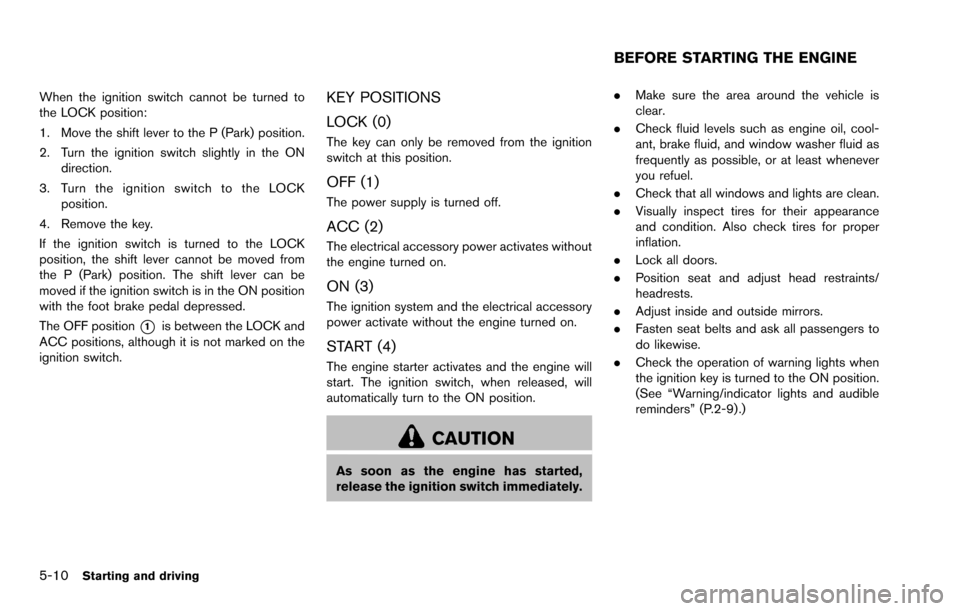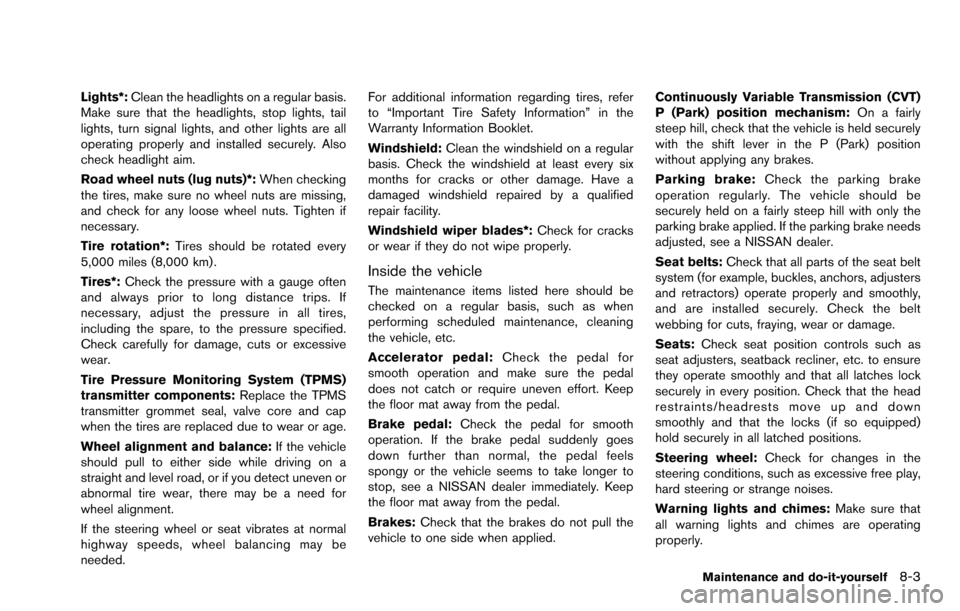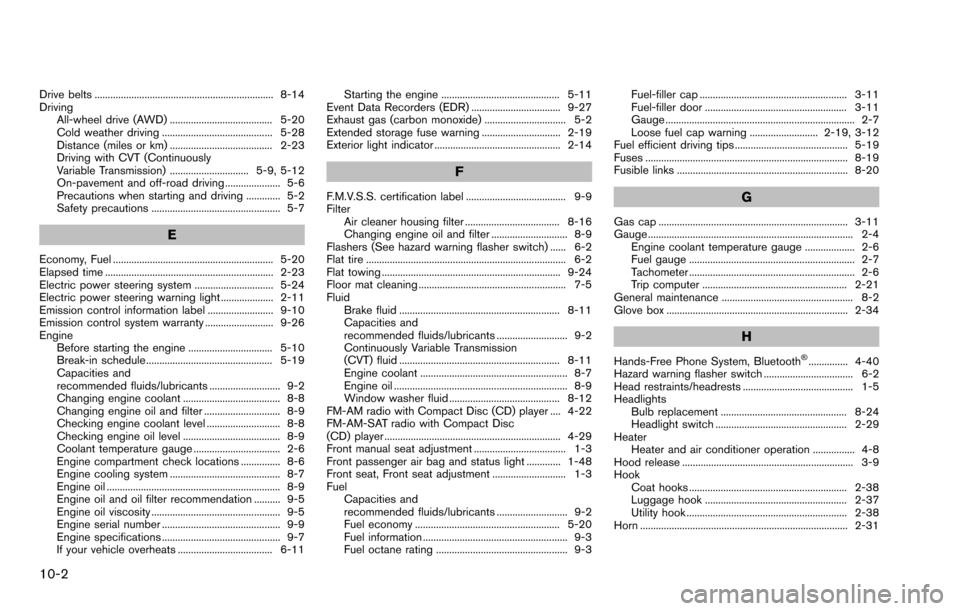2015 NISSAN ROGUE SELECT headrest
[x] Cancel search: headrestPage 197 of 322

5-10Starting and driving
When the ignition switch cannot be turned to
the LOCK position:
1. Move the shift lever to the P (Park) position.
2. Turn the ignition switch slightly in the ONdirection.
3. Turn the ignition switch to the LOCK position.
4. Remove the key.
If the ignition switch is turned to the LOCK
position, the shift lever cannot be moved from
the P (Park) position. The shift lever can be
moved if the ignition switch is in the ON position
with the foot brake pedal depressed.
The OFF position
*1is between the LOCK and
ACC positions, although it is not marked on the
ignition switch.
KEY POSITIONS
LOCK (0)
The key can only be removed from the ignition
switch at this position.
OFF (1)
The power supply is turned off.
ACC (2)
The electrical accessory power activates without
the engine turned on.
ON (3)
The ignition system and the electrical accessory
power activate without the engine turned on.
START (4)
The engine starter activates and the engine will
start. The ignition switch, when released, will
automatically turn to the ON position.
CAUTION
As soon as the engine has started,
release the ignition switch immediately. .
Make sure the area around the vehicle is
clear.
. Check fluid levels such as engine oil, cool-
ant, brake fluid, and window washer fluid as
frequently as possible, or at least whenever
you refuel.
. Check that all windows and lights are clean.
. Visually inspect tires for their appearance
and condition. Also check tires for proper
inflation.
. Lock all doors.
. Position seat and adjust head restraints/
headrests.
. Adjust inside and outside mirrors.
. Fasten seat belts and ask all passengers to
do likewise.
. Check the operation of warning lights when
the ignition key is turned to the ON position.
(See “Warning/indicator lights and audible
reminders” (P.2-9).)
BEFORE STARTING THE ENGINE
Page 244 of 322

Lights*:Clean the headlights on a regular basis.
Make sure that the headlights, stop lights, tail
lights, turn signal lights, and other lights are all
operating properly and installed securely. Also
check headlight aim.
Road wheel nuts (lug nuts)*: When checking
the tires, make sure no wheel nuts are missing,
and check for any loose wheel nuts. Tighten if
necessary.
Tire rotation*: Tires should be rotated every
5,000 miles (8,000 km) .
Tires*: Check the pressure with a gauge often
and always prior to long distance trips. If
necessary, adjust the pressure in all tires,
including the spare, to the pressure specified.
Check carefully for damage, cuts or excessive
wear.
Tire Pressure Monitoring System (TPMS)
transmitter components: Replace the TPMS
transmitter grommet seal, valve core and cap
when the tires are replaced due to wear or age.
Wheel alignment and balance: If the vehicle
should pull to either side while driving on a
straight and level road, or if you detect uneven or
abnormal tire wear, there may be a need for
wheel alignment.
If the steering wheel or seat vibrates at normal
highway speeds, wheel balancing may be
needed. For additional information regarding tires, refer
to “Important Tire Safety Information” in the
Warranty Information Booklet.
Windshield:
Clean the windshield on a regular
basis. Check the windshield at least every six
months for cracks or other damage. Have a
damaged windshield repaired by a qualified
repair facility.
Windshield wiper blades*: Check for cracks
or wear if they do not wipe properly.
Inside the vehicle
The maintenance items listed here should be
checked on a regular basis, such as when
performing scheduled maintenance, cleaning
the vehicle, etc.
Accelerator pedal: Check the pedal for
smooth operation and make sure the pedal
does not catch or require uneven effort. Keep
the floor mat away from the pedal.
Brake pedal: Check the pedal for smooth
operation. If the brake pedal suddenly goes
down further than normal, the pedal feels
spongy or the vehicle seems to take longer to
stop, see a NISSAN dealer immediately. Keep
the floor mat away from the pedal.
Brakes: Check that the brakes do not pull the
vehicle to one side when applied. Continuously Variable Transmission (CVT)
P (Park) position mechanism:
On a fairly
steep hill, check that the vehicle is held securely
with the shift lever in the P (Park) position
without applying any brakes.
Parking brake: Check the parking brake
operation regularly. The vehicle should be
securely held on a fairly steep hill with only the
parking brake applied. If the parking brake needs
adjusted, see a NISSAN dealer.
Seat belts: Check that all parts of the seat belt
system (for example, buckles, anchors, adjusters
and retractors) operate properly and smoothly,
and are installed securely. Check the belt
webbing for cuts, fraying, wear or damage.
Seats: Check seat position controls such as
seat adjusters, seatback recliner, etc. to ensure
they operate smoothly and that all latches lock
securely in every position. Check that the head
restraints/headrests move up and down
smoothly and that the locks (if so equipped)
hold securely in all latched positions.
Steering wheel: Check for changes in the
steering conditions, such as excessive free play,
hard steering or strange noises.
Warning lights and chimes: Make sure that
all warning lights and chimes are operating
properly.
Maintenance and do-it-yourself8-3
Page 313 of 322

10-2
Drive belts .................................................................... 8-14
DrivingAll-wheel drive (AWD) ....................................... 5-20
Cold weather driving .......................................... 5-28
Distance (miles or km) ....................................... 2-23
Driving with CVT (Continuously
Variable Transmission) .............................. 5-9, 5-12
On-pavement and off-road driving ..................... 5-6
Precautions when starting and driving ............. 5-2
Safety precautions ................................................. 5-7
E
Economy, Fuel ............................................................. 5-20
Elapsed time ................................................................ 2-23
Electric power steering system .............................. 5-24
Electric power steering warning light .................... 2-11
Emission control information label ......................... 9-10
Emission control system warranty .......................... 9-26
EngineBefore starting the engine ................................ 5-10
Break-in schedule ................................................ 5-19
Capacities and
recommended fluids/lubricants ........................... 9-2
Changing engine coolant ..................................... 8-8
Changing engine oil and filter ............................. 8-9
Checking engine coolant level ............................ 8-8
Checking engine oil level ..................................... 8-9
Coolant temperature gauge ................................. 2-6
Engine compartment check locations ............... 8-6
Engine cooling system .......................................... 8-7
Engine oil .................................................................. 8-9
Engine oil and oil filter recommendation .......... 9-5
Engine oil viscosity ................................................. 9-5
Engine serial number ............................................. 9-9
Engine specifications ............................................. 9-7
If your vehicle overheats .................................... 6-11 Starting the engine ............................................. 5-11
Event Data Recorders (EDR) .................................. 9-27
Exhaust gas (carbon monoxide) ............................... 5-2
Extended storage fuse warning .............................. 2-19
Exterior light indicator ................................................ 2-14
F
F.M.V.S.S. certification label ...................................... 9-9
Filter Air cleaner housing filter .................................... 8-16
Changing engine oil and filter ............................. 8-9
Flashers (See hazard warning flasher switch) ...... 6-2
Flat tire ............................................................................ 6-2
Flat towing .................................................................... 9-24
Floor mat cleaning ........................................................ 7-5
Fluid Brake fluid ............................................................. 8-11
Capacities and
recommended fluids/lubricants ........................... 9-2
Continuously Variable Transmission
(CVT) fluid ............................................................. 8-11
Engine coolant ........................................................ 8-7
Engine oil .................................................................. 8-9
Window washer fluid .......................................... 8-12
FM-AM radio with Compact Disc (CD) player .... 4-22
FM-AM-SAT radio with Compact Disc
(CD) player ................................................................... 4-29
Front manual seat adjustment ................................... 1-3
Front passenger air bag and status light ............. 1-48
Front seat, Front seat adjustment ............................ 1-3
Fuel Capacities and
recommended fluids/lubricants ........................... 9-2
Fuel economy ....................................................... 5-20
Fuel information ....................................................... 9-3
Fuel octane rating .................................................. 9-3 Fuel-filler cap ........................................................ 3-11
Fuel-filler door ...................................................... 3-11
Gauge ........................................................................ 2-7
Loose fuel cap warning .......................... 2-19, 3-12
Fuel efficient driving tips ........................................... 5-19
Fuses ............................................................................. 8-19
Fusible links ................................................................. 8-20G
Gas cap ........................................................................ 3-11
Gauge .............................................................................. 2-4 Engine coolant temperature gauge ................... 2-6
Fuel gauge ............................................................... 2-7
Tachometer ............................................................... 2-6
Trip computer ....................................................... 2-21
General maintenance .................................................. 8-2
Glove box ..................................................................... 2-34
H
Hands-Free Phone System, Bluetooth�Š............... 4-40
Hazard warning flasher switch .................................. 6-2
Head restraints/headrests .......................................... 1-5
Headlights Bulb replacement ................................................ 8-24
Headlight switch .................................................. 2-29
Heater Heater and air conditioner operation ................ 4-8
Hood release ................................................................. 3-9
Hook Coat hooks ............................................................ 2-38
Luggage hook ...................................................... 2-37
Utility hook ............................................................. 2-38
Horn ............................................................................... 2-31